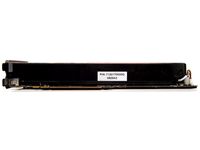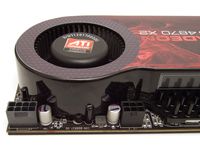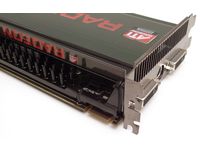Radeon HD 4870 X2: Four Cards Compared
Radeon HD 4870 X2 Specifications and Ports
Up until recently, dual-chip cards have suffered several disadvantages. An important one was that the GPU and memory speeds had to be lowered to compensate for the thermal and electrical demands of doubling up on one card’s attributes. Naturally, performance would drop as a result, making two single cards in CrossFire mode faster. Driver optimizations also usually took longer; the HD 3870 X2 had a long lead time before we could actually see optimized results.
The biggest advantage of double-chip cards, though, is that you only need one PCIe slot, giving you more options to choose from when it comes to picking a favorite motherboard.
AMD has made several improvements with its Radeon HD 4870 X2, making the current X2 card more attractive than its predecessors. It supports PowerPlay for lower power consumption, which is still missing for the single-chip HD 4870 with Catalyst 8.10 (it consumes 20 watts more per graphics chip in 2D mode). The X2 also boasts the single card’s full clock rate of 750 MHz and memory running at 900 MHz (or GDDR5 clock speed 3600 MHz), full 2x1024 MB graphics memory, and a fan that isn’t louder than two single cards. However, the noise level can vary if the fan profile is changed (like with the MSI OC edition).
AMD’s Radeon 4870 supports DirectX 10.1 with Shader 4.1, and can provide 8 channel audio to the HDMI port. There is no need for internal wiring; you only need a DVI HDMI adapter, which was shipped with all of the test cards. There are two DVI ports and one component video output, too.
Power comes from 6-pin and 8-pin plugs. The test system with its overclocked quad-core CPU consumes 480 watts from the socket. For the power supply, this means a load of 408 watts and 34 amps at 12 V. In 2D mode, the clock speed is lowered to 507 MHz GPU and 500 MHz memory, causing the power consumption to drop down to 202 watts (as long as you don’t get stuck with 240 watts after Vista restart because of the driver error). By contrast, the single-chip Radeon HD 4870 does not lower the clock speed with Catalyst 8.10, consuming 280 watts when two cards are combined in CrossFire mode.
To drive the dual-chip card properly, you really need a good, fast CPU. There is a 21.2% difference in overall performance between the standard CPU X6800 Extreme Edition at 2.93 GHz and an overclocked quad-core CPU QX6850 at 3.67 GHz. Of course, you can also combine two Radeon HD 4870 X2 via CrossFire (4CF), combining the cooperative efforts of four graphics chips. But the gain in overall performance is rather low here because the CPU limits the capabilities of this arrangement. For more information on how the various platforms scale with increased graphics horsepower, check out Core i7: 4-Way CrossFire, 3-way SLI, Paradise?


Get Tom's Hardware's best news and in-depth reviews, straight to your inbox.
Current page: Radeon HD 4870 X2 Specifications and Ports
Prev Page Problems with Catalyst 8.10: Part 2 Next Page Asus Radeon HD 4870 X2 Top (EAH4870X2 TOP/HTDI/2G/A)-
Not only do we have four super-fast Radeon HD 4870 X2s to test, but also a list of 31 other graphics configurations including CrossFire and SLI setups. If you're in the market for AMD's fastest card available, you'll want to see this.Reply
Radeon HD 4870 X2: Four Cards Compared : Read more -
neiroatopelcc "Because of accessories and price, Sapphire is our best-buy recommendation."Reply
One slight warning about sapphire though. If you have problems, don't expect their support team to help you before you've solved the problem yourself!
I made a ticket regarding some issues with my 4870 on august 7th, and received a reply on the 26th of september! That's 46 days to address an error they simply stated would go away with a bios upgrade from their homepage!
As for the article, I actually liked the detailed driver errors they encountered. Not that I liked the errors themselves, but I liked them being explained. Usually you just read 'after spending some hours resolving driver errors ....' without getting any wiser. -
Pei-chen Wow, AMD cards consume power like a Detroit SUV. I like Nvidia GTX 2xx series’ Toyota Prius like efficiency at idle.Reply -
ilovebarny Why didnt they use the GTX260 Core 216? its like way better than the regular GTX260. And i just read yesterday that Nvidia was only going to make GTX260 Core 216 now. http://www.fudzilla.com/index.php?option=com_content&task=view&id=10497&Itemid=1Reply -
enforcer22 Pei-chenWow, AMD cards consume power like a Detroit SUV. I like Nvidia GTX 2xx series’ Toyota Prius like efficiency at idle.Reply
Hmm your right. Power house vs crippled mouse.. yeah your analagy sucked im sure mine did to but all i saw from what you typed was i like weak stuff dont give me more power. -
bdollar seems to me if you are going to be comparing the highest end cards and even crossfire them for 4x you would have the highest resolution as one of the options. i would think people considering going x2 in crossfire would consider a 30" screen.Reply
don't get me wrong, i liked the article but would have liked to have seen the resolution spectrum hit the top. -
It's nice to see the 9800GX2 included in the tests. I was considering the 4870x2 due to all the rave reviews but they never had the comparison like this against my current 9800GX2. I won't be getting new card anytime soon it seems. Thanks.Reply



